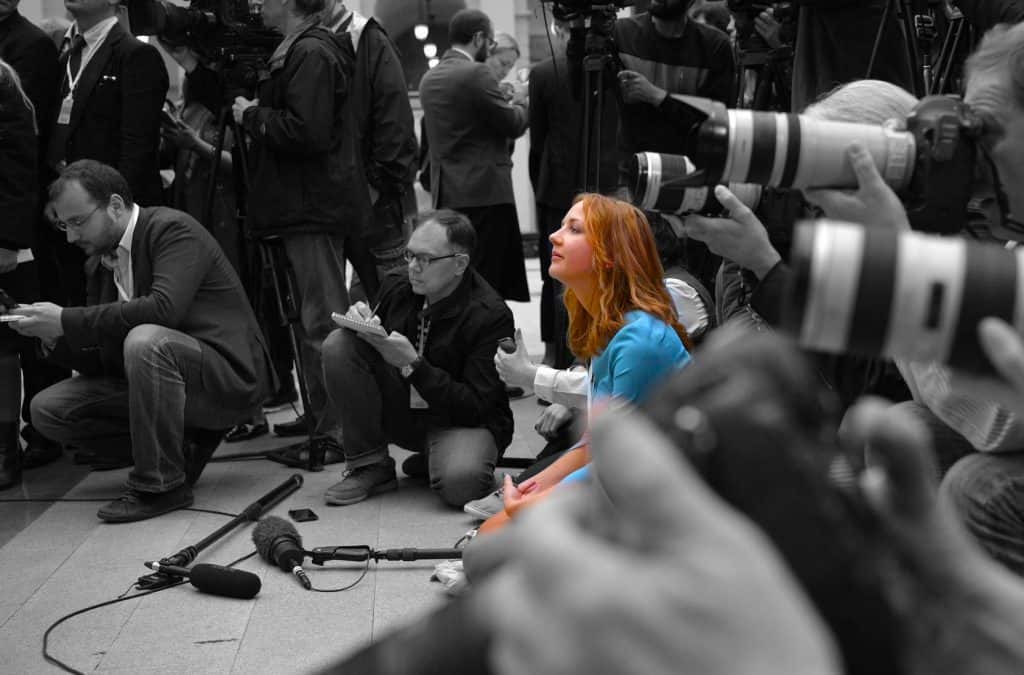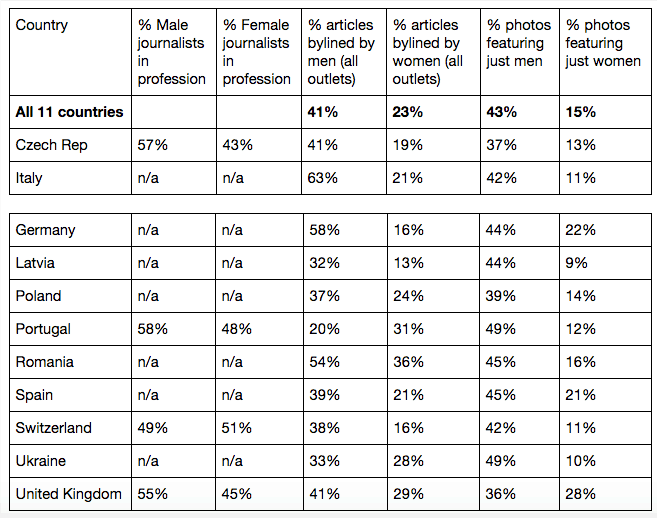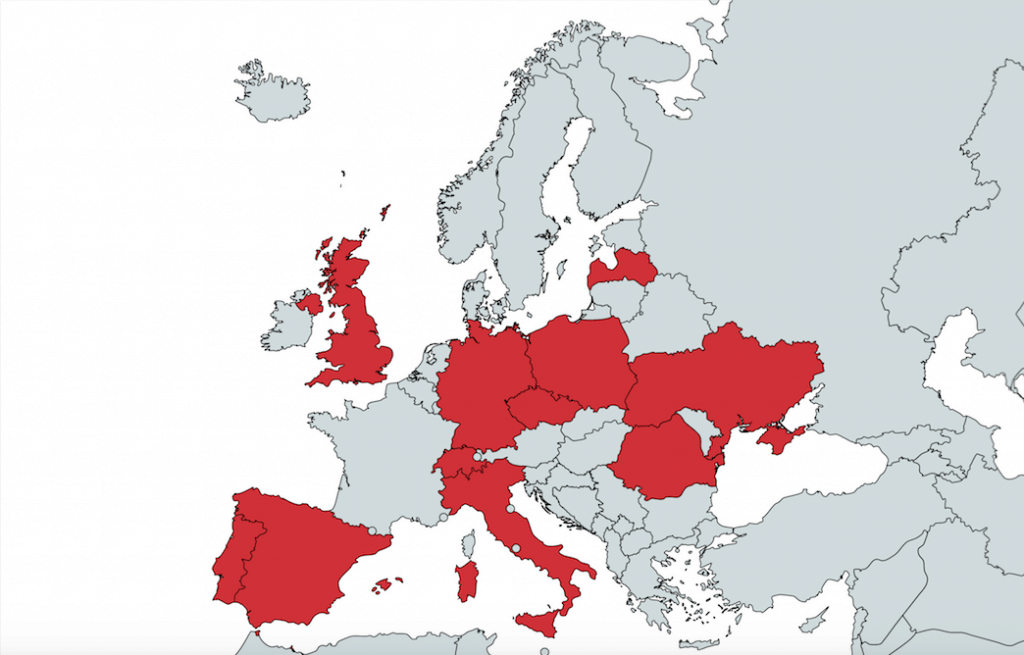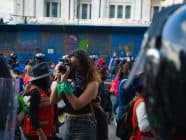
News coverage in Europe is overwhelmingly dominated by male journalists and commentators, who spend much of their time writing about other men, a landmark new study of print and online news outlets has found.
The supremacy of men in shaping and covering the continent’s news agenda endures despite the fact that in many of the 11 countries surveyed, women make up around half the number of journalists and more women than men are choosing journalism as a career.
European Journalism Is A Largely Male Affair
The researchers, who looked at reporters’ bylines and the images accompanying stories, found that in nearly every country, across both print and digital, men wrote most of the content in the news, business, and comment sections. Across all 11 countries, men wrote 41% of the stories, compared to just 23% written by women, while almost half of all the pictures (43%) that were published were just of men, compared to just 15% featuring only women. The balance was made up of un-bylined /agency articles.
The journalistic study discovered that the gender imbalance was generally more obvious in traditional print media. Digital-born news outlets on the whole had a slightly more equal balance, although most of these, too, favoured male bylines and photographs of men. In some countries and outlets, more articles were published under anonymous agency bylines than by female reporters.
The nations that demonstrated the biggest gender imbalance in bylines were Italy and Germany. In Germany, 58% of bylines were male and just 16% female, while in Italy, 63% of bylines (the highest percentage among the 11 countries) belonged to men, and just 21% to women.
The worst offender in terms of use of pictures was Ukraine, where 49% of the photos were of men only, compared to 10% depicting just women.
The only exception to the male supremacy was Portugal, where female bylines were more frequent than for men, by 31% to 20%. But even here, the use of photographs of males dwarfed those of women, by 49% to 12%.

Method
The journalistic study, conducted by the European Journalism Observatory (EJO) – a network of 12 language sites based in universities and media research institutes across Europe – was based on content analysis of the news, comment and business sections of two print and two digital-born news outlets in each country on the same two days a week over four weeks in January and February this year. The countries looked at were the Czech Republic, Germany, Italy, Latvia, Poland, Portugal, Romania, Spain, Switzerland, Ukraine and the United Kingdom.
For the purpose of uniformity, only the first 15 pages of each print newspaper were studied, as these would feature the most high-profile or important stories of the day. With digital news outlets, the first 20 stories on the home page, in news, politics and business, were chosen. Features about health, arts and lifestyle issues such as fashion were omitted, as were sports sections. In each country one quality and one popular or tabloid print title was chosen, plus two digital-born (where possible) news sites, again these were chosen to represent one quality and one popular outlet.
In each country one quality and one popular – or tabloid – print title was chosen, plus two digital-born (where possible) news sites, these were also chosen to represent one quality and one popular outlet, or as close as possible to those criteria.
“They should challenge their own way of thinking”
The findings caused dismay among female journalists across Europe, some of whom blamed the imbalance on the enduring culture of newsrooms, which is often macho, high-paced and demanding, particularly in terms of long, unsociable, un-family friendly hours.
Professor Suzanne Franks, Head of Department of Journalism at London’s City University and author of a number of landmark research projects into women in journalism said the report highlighted long-standing inequalities within the profession.
“It is excellent that we have here such a wide-ranging and comprehensive study comparing gender disparities across so many countries. What is not so good is the persistence of the same disparities between who is being published and also who is featuring in news images. Let’s hope that by highlighting once again these gender biases in journalism we will see concerted efforts for change.”
Susanne Klingner, a German journalist with more than ten years experience in the field of gender equality, including developing Plan W, a business magazine for women, for a leading newspaper, Sueddeutsche Zeitung, said she was not surprised that Germany performed so badly in the study. “In every OECD study Germany is at the bottom of the scale regarding gender balance,” she said. “I would like to say that this bad outcome has to do with the selection of news outlets since there is no progressive paper like SZ or DIE ZEIT in the study, but I am afraid it would not have changed too much.” Klingner said improving gender balance is not yet a commercial imperative in Germany, despite attempts by individual papers, such as DIE ZEIT to improve the ratio between male and female staff. “95% of German newspapers are led by men.”
“I have seen it so many times. Young people who start within a news organisation are not judged by performance, but by feelings, and the old white (another lack of diversity in Germany) male editors feel close to the young, white male editors. They see themselves as beginners and promote them. Many young women stay unseen, no matter how talented they are. They just do not have the same number of advocates in the company. The moment there are enough women in leading roles this will change….News companies are failing because they think being progressive only means reporting progressively, but not necessarily being a progressive company… and the conservative companies do not care.”
“They should challenge their own way of thinking,” Klingner added.
* * *
A Country By Country Overview Of The Findings

The sample countries: Czech Republic, Germany, Italy, Latvia, Poland, Portugal, Romania, Spain, Switzerland, United Kingdom, Ukraine.
1. Czech Republic
Czech national newspapers and leading online news sites are largely dominated by men, with one notable exception. Taken as a whole, male journalists made up 41% of all bylines compared to 19% for females. This gap became even more pronounced in business stories (80% male) and in comment articles (90% male).
These findings are despite the fact that more women than men enter university journalism courses; At Charles University in Prague, one of four journalism programmes in the Czech Republic, there have been more female applicants than male to the journalism course for the past five years. This academic year 217 women and 168 men are enrolled on the journalism programme.
Only a leading digital news site, Seznamzpravy.cz, bucked the trend. The site, which launched in 2016, had more articles written by women during the study period (53% female versus 40% male). On one of the days studied, Seznamzpravy boasted 12 female bylines compared to five for men; on the same day, by contrast, Aktuane, another online news site, had two female bylines and 12 male; MF DNES, a national paper in the political centre, had five female and 12 male; Pravo, a national daily paper considered to be on the left, had just three female and 26 male.
There were three times more photographs of men used across all outlets. Pictures usually showed women involved in normal daily life, whereas men were usually depicted in the role of politicians or experts (148 male politicians compare to 26 female politicians; 21 male experts compare to six female experts). Frequent over-representation of images of male politicians may be a result of fewer women entering politics (for example, only 22% of Czech MPs are women). On some days, in some outlets, there were 10 photos of men, and none of women. On other occasions, the main pictures selected of women were of scantily clad women from the Rio carnival.
2. Germany
News coverage in German is largely a male affair. Overall, taking all four news outlets studied, 58% of bylines were from men and just 16% from women, while 43% of the photographs published were of men, with only 22% of females. This in a country where the Chancellor is a woman, and another woman has just been elected leader of the Social Democrats.
In the FAZ, historically a male-dominated conservative newspaper with a low staff turnover, a huge 81% of the stories were by male journalists, and just 13% by women. Most economic and political pieces had male bylines, with a few exceptions; females were mostly restricted to arts and culture reporting. The situation with photographs was much the same: 38% were of men only, compared to 14% for women.

In the German newspaper, Faz, 81% of bylines were male and 38% of pictures were of men only, (compared to 14% of women).
In BILD, the country’s largest (conservative) tabloid, there was a slightly more even distribution of bylines, but still heavily skewed towards men (39% male versus 14% female), although its photos of women focused more often than not on sexualised contexts, such as women in bikinis, or the girlfriends or wives of famous athletes or actors.
Bento, a news website that is geared towards a younger, more liberal audience and frequently features topics such as “gender”, “women’s rights” and “racism”, fared the best. Female bylines made up 38% of its stories, compared to 58% male. Photographs of females comprised 27% of the total, against 36% of men.
The second digital outlet examined, T-online, did not do so well. Female bylines were just five per cent of the total, versus 27% male, while its photographs were 46% male, 23% female. The balance of content was provided by un-bylined agency material.
3. Italy
Italian data show a strong majority of male authors and photos across the whole sample. All the four news outlets featured more male authors and published more male pictures on each of the days analysed, both online and in print. Of a total of 594 bylines, 373 (63%) were male and 123 (21%) female, while the remaining 98 were divided by “other” and “agencies”. In terms of photos, overall 42% were of men, and just 12% of women.
Only four per cent of the photographs in La Repubblica, the centre-left newspaper, were of women, while 33% were of men. Sixty-eight per cent of its bylines were male; 28% female.
The other newspaper looked at, the liberal-centrist Corriere della Sera, was not much better: bylines favoured men by 74% to 23% and photographs by 43% to 16%.
The two digital outlets, Linkiesta.it and HuffPost.it, are doing just as badly when it comes to representation of women in news. Linkiesta’s bylines were 67% male to 15% female, while HuffPost’s were 35% male to 16% female. Their respective photograph performance was also heavily male-oriented: 46% to 13% and 42% to 11%.
4. Latvia
Journalism in Latvia has historically been a female-dominated occupation, but only 13% of all bylines across the four outlets – Latvijas Avize, Segodna, Delfi, Tvnet – belonged to females, while 32% of articles were by men.
Even then, a considerable number of articles (54%) did not give a clear clue who did the writing, because 30% of bylines were no-name pieces, or belong to international or national news agencies (24 %). Fewer than 10% of pictures featured just women, compared to 44% displaying men only.
A huge 85% of the bylines in Segodna, a tabloid-style Russian language newspaper, were by men, and just 14% were by females. Latvijas Avize, a quality newspaper, did better, with a ratio of 34% male to 18% female. Online outlets were more evenly-balanced: Delfi, the country’s most popular online news source, demonstrated a rare bias in favour of women: with just six per cent of its bylines from men and 19% from women (the biggest single contributor was agencies, accounting for 33% of the stories on the site).
The second digital news site – Tvnet, a more tabloid-type media – carried very few bylined articles.
All the outlets had a heavy prejudice towards publishing photographs of men, with not one having more than 11% of their pictures featuring just women.
5. Poland
A significant majority of news items in all media were created by male journalists (37%), versus 24% by female journalists. Interestingly, the number of anonymous news items (35% of all news content) exceeded the number of news items created by female journalists.
The best outlet in terms of gender equality was the digital news site, Wp.pl: 40% of its stories were created by female journalists compared to 58% by men.
Second best was the newspaper, Gazeta Wyborcza with 55% of content created by men and 33% by women. This, however, will probably be regarded as a disappointment by Gazeta as it is the only openly pro-gender equality, leftist daily paper in Poland. Of the eight research days, only on one did the number of stories created by women exceed the number of those by men (by 10 to eight).
The other digital outlet, Onet.pl, didn’t score well. Altogether, the content created by women represented 16% while men accounted for 27%, with the majority (56%) of content coming from agencies or other media with no byline.
Fakt (RASP), tabloid with the biggest circulation of all dailies, demonstrated a much more balanced approach, with 10% of its stories written by males and nine per cent by women. However, 80% of its stories either had no name or were by agencies.
There was not a single day during the research when the number of photos depicting women exceeded number of photos depicting men. Overall, 39% of all photos were of men only, and just 14% of women only. On couple occasions, even the stories evidently about women (e.g. interviews with female members of the parliament) were illustrated with photos depicting men only mentioned in the articles.
6. Portugal
Portugal was a rare outlier among Europe’s media: the number of bylines written by women in the news outlets analysed was 30%, compared to 20% by men.
The female supremacy was even greater in print newspapers, with women writing 37 % of news stories there against only 18% written by men.
Content from news agencies ruled at the online outlets, especially at Notícias ao Minuto, where almost half of the news came from agencies (mainly LUSA, the Portuguese news agency). Here, men and women were more even in regard to bylines (22% for men and 24% for women).
It is unclear why Portugal of all the countries studied should show a bias towards females. A recent survey showed that that 52% of Portuguese journalists were men, with 48% women.
The same study revealed that male journalists tended to be paid more than females, leaving many women less satisfied about their salaries than men (37% of women journalists say they are very unsatisfied against 30% of men saying the same). These pay disparities persist despite the fact that 54% of women journalists in Portugal have a university degree against 34% for men.
That there are more bylines by women could suggest that men are in higher places in the hierarchy, in the role of directors or editors or others, and therefore write fewer stories or none at all. This theory is borne out by a panel at last year’s annual Journalist’s Congress, held in Lisbon, made up of the directors of the main media outlets. Only two of 19 panellists, were female.
7. Romania
Hotnews.ro, one of the most popular Romanian online news outlets, bucked the trend in this country and the rest of Europe (Portugal excepted) by displaying a clear predisposition towards favouring female journalists. Fifty-seven per cent of its articles had female bylines, compared to 43 % for men.
The quality newspaper, Adevarul, also performed creditably, with 44% of its articles written by men versus 38% by females. All the articles in the Foreign section were written by female journalists during the days of the study, although front-page stories in the paper (and on the other newspaper analysed, Libertatea) tended to be written by men. It was also noted that articles written by the female journalists on both Hotnews and Adevarul were generally much shorter than those written by the male journalists.
Although the other outlets gave more traditional results in favour of men (the worst performer was the second digital outlet studied, stiripesurse.ro, which had 83% of its bylines by men and just 17% by females), the overall view of Romania news media in terms of bylines was 54% male to 36% female.
In terms of use of pictures, all outlets used many more photographs of men alone, rather than of women. Combined, 45% of the photos published were just of men, compared to 16% being just of women.
8. Spain
Men dominate the Spanish news media landscape, despite more than half of the country’s journalists being women. Overall, 39% of the articles analysed in El País, El Mundo, HuffPost and El Español were bylined by male journalists, compared to 21% by women. On some of the days studied, more than 80% of the articles in one or more of the outlets were written by men.
Use of photos was also skewed towards the masculine, with 45% featuring just males, compared to 21% of females. In the print editions of the newspapers El Mundo and El País, a clear difference in the size of the photo was noticeable; when female politicians (for example Vice President Saenz de Santamaría or Angela Merkel) were featured, their pictures tended to be smaller than when a male politician was used.
El País was the worst offender in terms of male bias in bylines (65% male versus 28% female), while HuffPost was the best (just 13% male versus eight per cent female). HuffPost also stood out for having a high number of articles written by mixed teams.
9. Switzerland
For the purpose of the study, two outlets publishing in German (the quality newspaper Neue Zürcher Zeitung and the digital native news platform Watson) were looked at as well as two in French (Le Temps newspaper and the news website of the public broadcaster, RTS Info).
As with most of the rest of Europe, Swiss media is overwhelmingly male: male bylines made up 38% of the overall articles, followed by agencies (27%), while female journalists wrote only 16%.
There were slight differences between French and German language outlets (28% male bylines versus 15% female in the francophone media and 39% versus 14 % in the German-language media), but not in terms of the use of photos, where German-language media had an even narrower gender gap.
Digital news platforms had a much smaller gender gap for bylines (male 19%, female 11%) compared to newspapers, in which almost half of the articles (48%) were written by men, while women provided only about 18% of the articles.
The lack of female representation in the production of articles is mirrored also in the visual aspect of content: overall, only 11% of pictures showed just women, while men were depicted in 42% of the photos. The remaining 47% of pictures had either both genders or neither of them.
Looking at the two media types separately, the online media does not differ much from the overall results, as only a minority of pictures showed women (10%), while most depicted both or neither (53%) or men (37%). In the print papers, more than half of all pictures showed men (55%), while 32% depicted both or neither of the genders, and women were also slightly more represented but still low (13%).
10. United Kingdom
Four news outlets were studied in the UK, two print: The Daily Telegraph, a quality broadsheet, The Sun, a popular tabloid newspaper, and two digital-born news sites, the UK editions of Buzzfeed and the International Business Times.
Of the print editions studied, The Sun was dominated by male reporters (40%) – women only wrote 12% of articles during the period studied. This was reflected in the content, as indicated by editorial photographs on the news pages. While there was a relatively high proportion of women (35% compared to 43% of men) appearing alone in images, they were predominantly featured scantily dressed, or, occasionally, being berated for appearing without make-up. The Sun is known – and unapologetic – about its revealing ‘Page Three’ pictures of women.
The Telegraph had a higher number of female bylines (33.5%) than male 28%. It also, during the period studied, appeared to take a strong stance on equality, with its female reporters criticising the BBC for its gender pay gap, a story that broke during February. However, on March 28, a few weeks after the EJO’s content analysis ended, The Telegraph revealed its own gender pay gap was the highest of any UK newspaper publisher or broadcaster at that point.
Women working at Telegraph Media Group (TMG) get paid 35% less than men on average, the biggest gender pay gap of any UK newspaper publisher or broadcaster to have reported official figures to date.

Kate McCann, the Telegraph’s senior political correspondent reacts on Twitter to news that female staff are paid 35% less than males on the paper.
Nick Hugh, the chief executive of Telegraph Media Group, recently said the pay gap was unacceptable and he committed to closing the gap to zero by 2025. Hugh said the publisher would introduce a 50:50 gender shortlists for all vacant positions and would do more to promote women to top jobs.
“While we are moving in the right direction, we have much to do,” Hugh said in a statement on the company’s website. “As of April 2017, our gender pay report shows an unacceptable gap between the average pay for men compared with women. The main reason for this has been a lack of female representation at the most senior levels, something which we have already started to address.”
Buzzfeed and the International Business Times were the two digital-born news sites chosen. Both are international outlets, but were among few UK news sites to offer enough content for the study of 20 news, comment and business articles a day. Of the two, Buzzfeed had more women writers (51%) than men (44%).
The IBT was very male-dominated – 68.5% of articles were by male writers and 24% by female. Shortly after the study was completed the IBT cut many of its staff in London.
According to UCAS, the UK’s university admissions body, more women attended journalism school on a full-time undergraduate basis than men, between 2007 and 2014. The same UCAS figures also reveal that despite the higher number of applications for journalism courses from women, men were more likely to be accepted onto the courses.
Although there is a relatively high proportion of women in the profession (45% of UK journalists are female) a 2016 Reuters Institute/Worlds of Journalism study of 700 UK journalists concluded that female journalists are “less well remunerated than men and are under-represented in senior positions.” This report also found female journalists are more likely to be at the lower end of the pay scale than men.
The print outlets (The Sun, The Telegraph) were chosen because a recent EJO study focused on other UK print outlets, although the findings of that study were broadly the same.
11. Ukraine
Female journalists here enjoy an equality when it comes to bylines, particularly in print media. Of the two newspapers analysed, one displayed more female bylines than male ones, while at the other the male and female bylines were equal. In Segodnya, a mass market daily, it was 51% to 40% in favour of women, while each gender had 37% of the bylines in Den, a quality daily newspaper.
The result was different with the two online news outlets studied (both digital born, ones of the most visited news websites in Ukraine). Both had a majority of male bylines: Censor, a news website which might be regarded as a patriotic one in the light of war, by 24% to 13%, and at Obozrevatel, a news outlet covering both sociopolitical and tabloid topics, by 29% to 10%. That meant the overall view across print and digital marginally came out in favour of men, who had 33% of the bylines compared to 28% for women.
These findings have to be put into some context. Ukrainian online media usually don’t put author bylines on news stories as a considerable amount of news content is simply rewritten from other sources (news websites, news agencies, etc). Any exclusive content provided by the website tends to be displayed with the website’s logo, rather than with the names of the journalists who created it. This may mask the true picture.
In the use of pictures, the situation was familiarly male-centric. Overall, 49% of the photos were of men alone, compared to 10% which just featured women. As with bylines, the print papers are better than their online rivals. While 15% of the photos in Den and 17% of those in Segodnya were of women, only seven per cent and six per cent of those used in Censor and in Obozrevatel were. This trend can partially be explained by the news agenda: the majority of stories tended to be dedicated to male characters (politicians, businessmen, soldiers, etc) while female characters were less common and less visible. This finding reflects the general situation in the country where women are still heavily underrepresented in politics (only 12 % of its MPs are female, though this is the biggest percentage of women in parliament since independence in 1991)
If you liked this story, you may also be interested in Where are all the Women Journalists in UK Newspapers?
Picture Credit: Kremlin Press Office.
Sign up for the EJO’s regular monthly newsletter or follow us on Twitter.
Tags: Czech Republic, discrimination, Europe, European Media, gender, Gender Equality, Germany, Italy, Journalism, journalists, Latvia, Newspapers, newsroom, Poland, Portugal, Reuters Institute for the Study of Journalism, Romania, Spain, Suzanne Franks, Switzerland, Ukraine, United Kingdom, Women in Journalism













































